Marketing Plan for Taco Bell in Australia
VerifiedAdded on 2022/11/18
|15
|3065
|448
AI Summary
Develop a marketing plan for Taco Bell in Australia to increase brand awareness, customer satisfaction, and revenue. Includes SWOT and PESTLE analysis, target customers, value proposition, positioning maps, and marketing tactics.
Contribute Materials
Your contribution can guide someone’s learning journey. Share your
documents today.
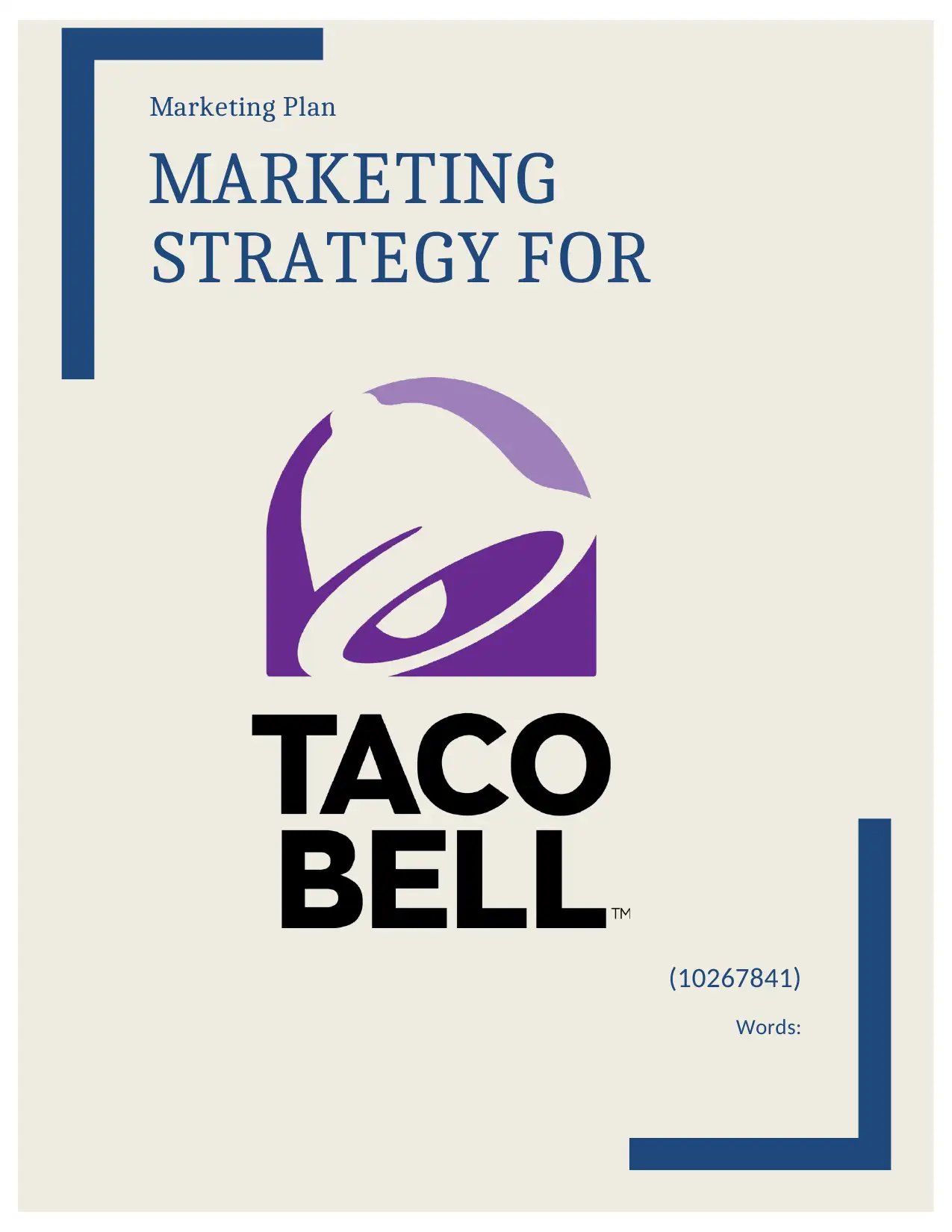
Marketing Plan
MARKETING
STRATEGY FOR
(10267841)
Words:
MARKETING
STRATEGY FOR
(10267841)
Words:
Secure Best Marks with AI Grader
Need help grading? Try our AI Grader for instant feedback on your assignments.
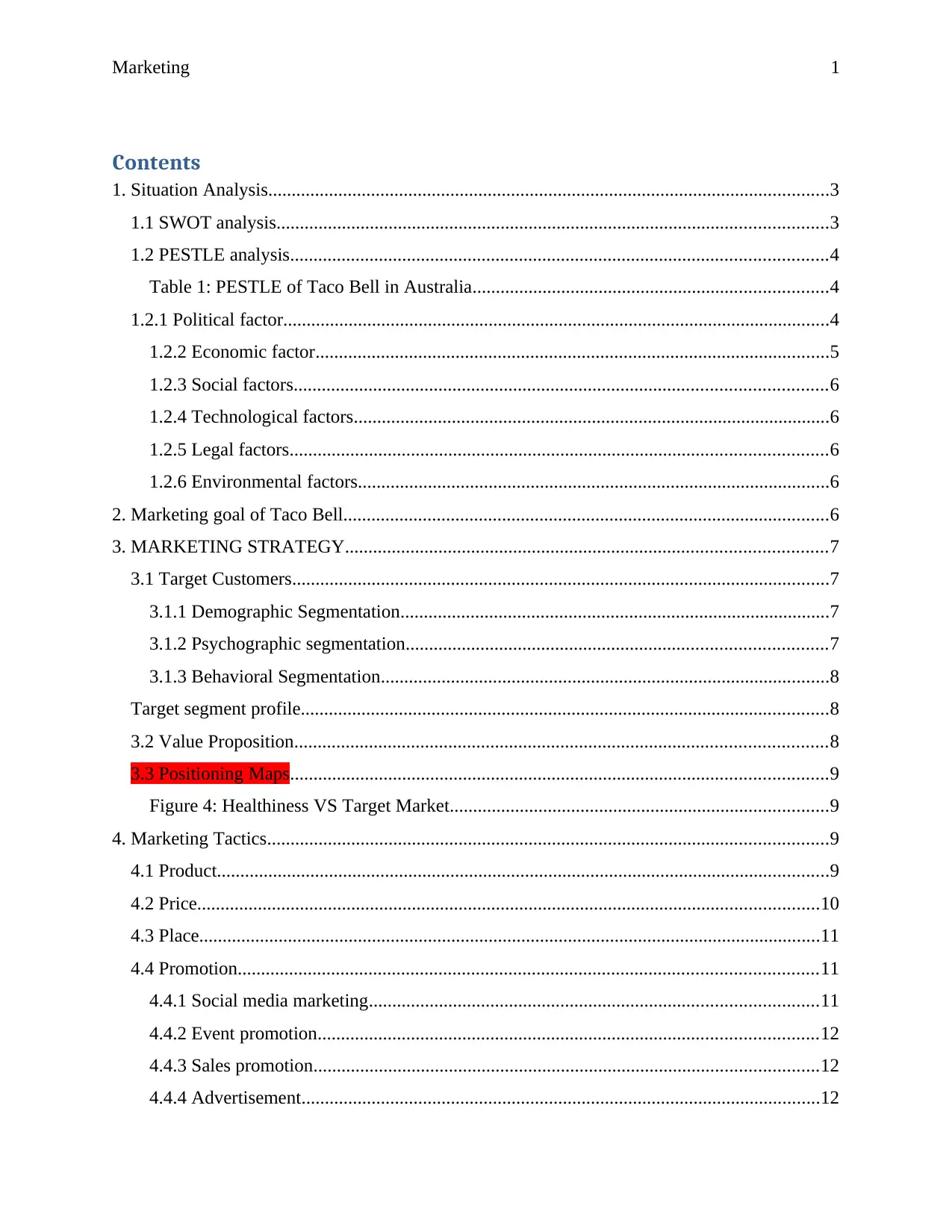
Marketing 1
Contents
1. Situation Analysis........................................................................................................................3
1.1 SWOT analysis......................................................................................................................3
1.2 PESTLE analysis...................................................................................................................4
Table 1: PESTLE of Taco Bell in Australia............................................................................4
1.2.1 Political factor.....................................................................................................................4
1.2.2 Economic factor..............................................................................................................5
1.2.3 Social factors..................................................................................................................6
1.2.4 Technological factors......................................................................................................6
1.2.5 Legal factors...................................................................................................................6
1.2.6 Environmental factors.....................................................................................................6
2. Marketing goal of Taco Bell........................................................................................................6
3. MARKETING STRATEGY.......................................................................................................7
3.1 Target Customers...................................................................................................................7
3.1.1 Demographic Segmentation............................................................................................7
3.1.2 Psychographic segmentation..........................................................................................7
3.1.3 Behavioral Segmentation................................................................................................8
Target segment profile.................................................................................................................8
3.2 Value Proposition..................................................................................................................8
3.3 Positioning Maps...................................................................................................................9
Figure 4: Healthiness VS Target Market.................................................................................9
4. Marketing Tactics........................................................................................................................9
4.1 Product...................................................................................................................................9
4.2 Price.....................................................................................................................................10
4.3 Place.....................................................................................................................................11
4.4 Promotion............................................................................................................................11
4.4.1 Social media marketing................................................................................................11
4.4.2 Event promotion...........................................................................................................12
4.4.3 Sales promotion............................................................................................................12
4.4.4 Advertisement...............................................................................................................12
Contents
1. Situation Analysis........................................................................................................................3
1.1 SWOT analysis......................................................................................................................3
1.2 PESTLE analysis...................................................................................................................4
Table 1: PESTLE of Taco Bell in Australia............................................................................4
1.2.1 Political factor.....................................................................................................................4
1.2.2 Economic factor..............................................................................................................5
1.2.3 Social factors..................................................................................................................6
1.2.4 Technological factors......................................................................................................6
1.2.5 Legal factors...................................................................................................................6
1.2.6 Environmental factors.....................................................................................................6
2. Marketing goal of Taco Bell........................................................................................................6
3. MARKETING STRATEGY.......................................................................................................7
3.1 Target Customers...................................................................................................................7
3.1.1 Demographic Segmentation............................................................................................7
3.1.2 Psychographic segmentation..........................................................................................7
3.1.3 Behavioral Segmentation................................................................................................8
Target segment profile.................................................................................................................8
3.2 Value Proposition..................................................................................................................8
3.3 Positioning Maps...................................................................................................................9
Figure 4: Healthiness VS Target Market.................................................................................9
4. Marketing Tactics........................................................................................................................9
4.1 Product...................................................................................................................................9
4.2 Price.....................................................................................................................................10
4.3 Place.....................................................................................................................................11
4.4 Promotion............................................................................................................................11
4.4.1 Social media marketing................................................................................................11
4.4.2 Event promotion...........................................................................................................12
4.4.3 Sales promotion............................................................................................................12
4.4.4 Advertisement...............................................................................................................12

Marketing 2
References......................................................................................................................................13
References......................................................................................................................................13
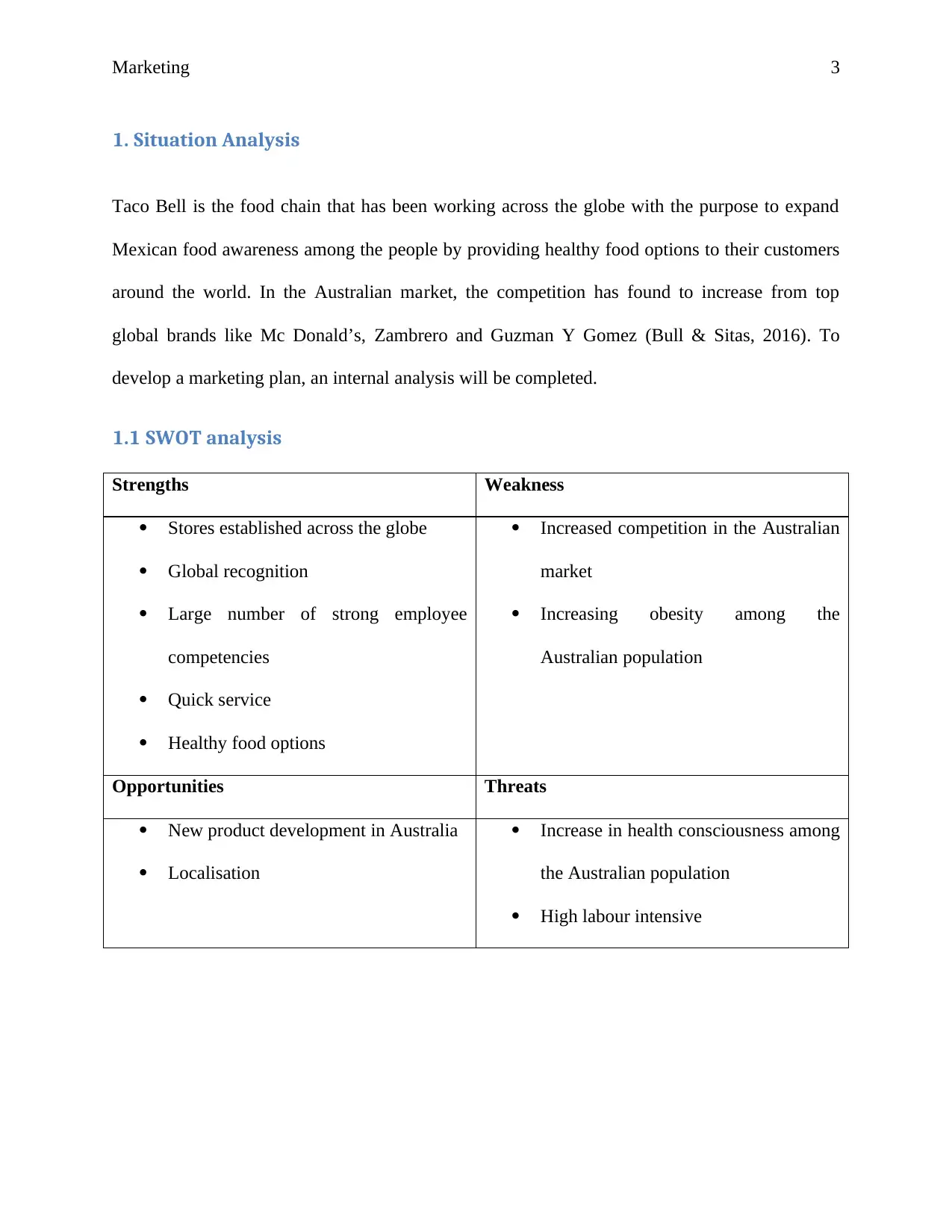
Marketing 3
1. Situation Analysis
Taco Bell is the food chain that has been working across the globe with the purpose to expand
Mexican food awareness among the people by providing healthy food options to their customers
around the world. In the Australian market, the competition has found to increase from top
global brands like Mc Donald’s, Zambrero and Guzman Y Gomez (Bull & Sitas, 2016). To
develop a marketing plan, an internal analysis will be completed.
1.1 SWOT analysis
Strengths Weakness
Stores established across the globe
Global recognition
Large number of strong employee
competencies
Quick service
Healthy food options
Increased competition in the Australian
market
Increasing obesity among the
Australian population
Opportunities Threats
New product development in Australia
Localisation
Increase in health consciousness among
the Australian population
High labour intensive
1. Situation Analysis
Taco Bell is the food chain that has been working across the globe with the purpose to expand
Mexican food awareness among the people by providing healthy food options to their customers
around the world. In the Australian market, the competition has found to increase from top
global brands like Mc Donald’s, Zambrero and Guzman Y Gomez (Bull & Sitas, 2016). To
develop a marketing plan, an internal analysis will be completed.
1.1 SWOT analysis
Strengths Weakness
Stores established across the globe
Global recognition
Large number of strong employee
competencies
Quick service
Healthy food options
Increased competition in the Australian
market
Increasing obesity among the
Australian population
Opportunities Threats
New product development in Australia
Localisation
Increase in health consciousness among
the Australian population
High labour intensive
Secure Best Marks with AI Grader
Need help grading? Try our AI Grader for instant feedback on your assignments.
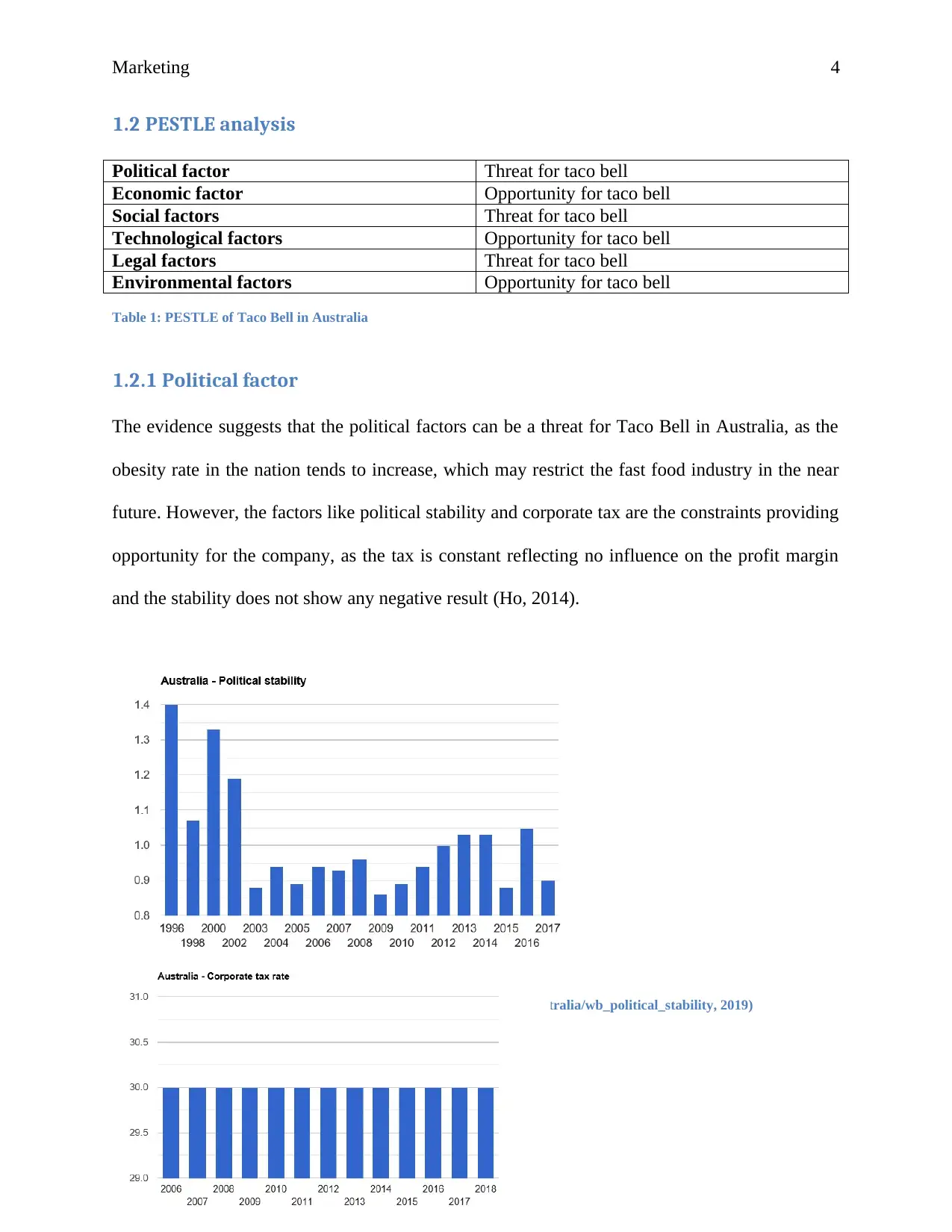
Marketing 4
1.2 PESTLE analysis
Political factor Threat for taco bell
Economic factor Opportunity for taco bell
Social factors Threat for taco bell
Technological factors Opportunity for taco bell
Legal factors Threat for taco bell
Environmental factors Opportunity for taco bell
Table 1: PESTLE of Taco Bell in Australia
1.2.1 Political factor
The evidence suggests that the political factors can be a threat for Taco Bell in Australia, as the
obesity rate in the nation tends to increase, which may restrict the fast food industry in the near
future. However, the factors like political stability and corporate tax are the constraints providing
opportunity for the company, as the tax is constant reflecting no influence on the profit margin
and the stability does not show any negative result (Ho, 2014).
Figure 1: Political Stability in Australia (Source: (theglobaleconomy, Australia/wb_political_stability, 2019)
1.2 PESTLE analysis
Political factor Threat for taco bell
Economic factor Opportunity for taco bell
Social factors Threat for taco bell
Technological factors Opportunity for taco bell
Legal factors Threat for taco bell
Environmental factors Opportunity for taco bell
Table 1: PESTLE of Taco Bell in Australia
1.2.1 Political factor
The evidence suggests that the political factors can be a threat for Taco Bell in Australia, as the
obesity rate in the nation tends to increase, which may restrict the fast food industry in the near
future. However, the factors like political stability and corporate tax are the constraints providing
opportunity for the company, as the tax is constant reflecting no influence on the profit margin
and the stability does not show any negative result (Ho, 2014).
Figure 1: Political Stability in Australia (Source: (theglobaleconomy, Australia/wb_political_stability, 2019)
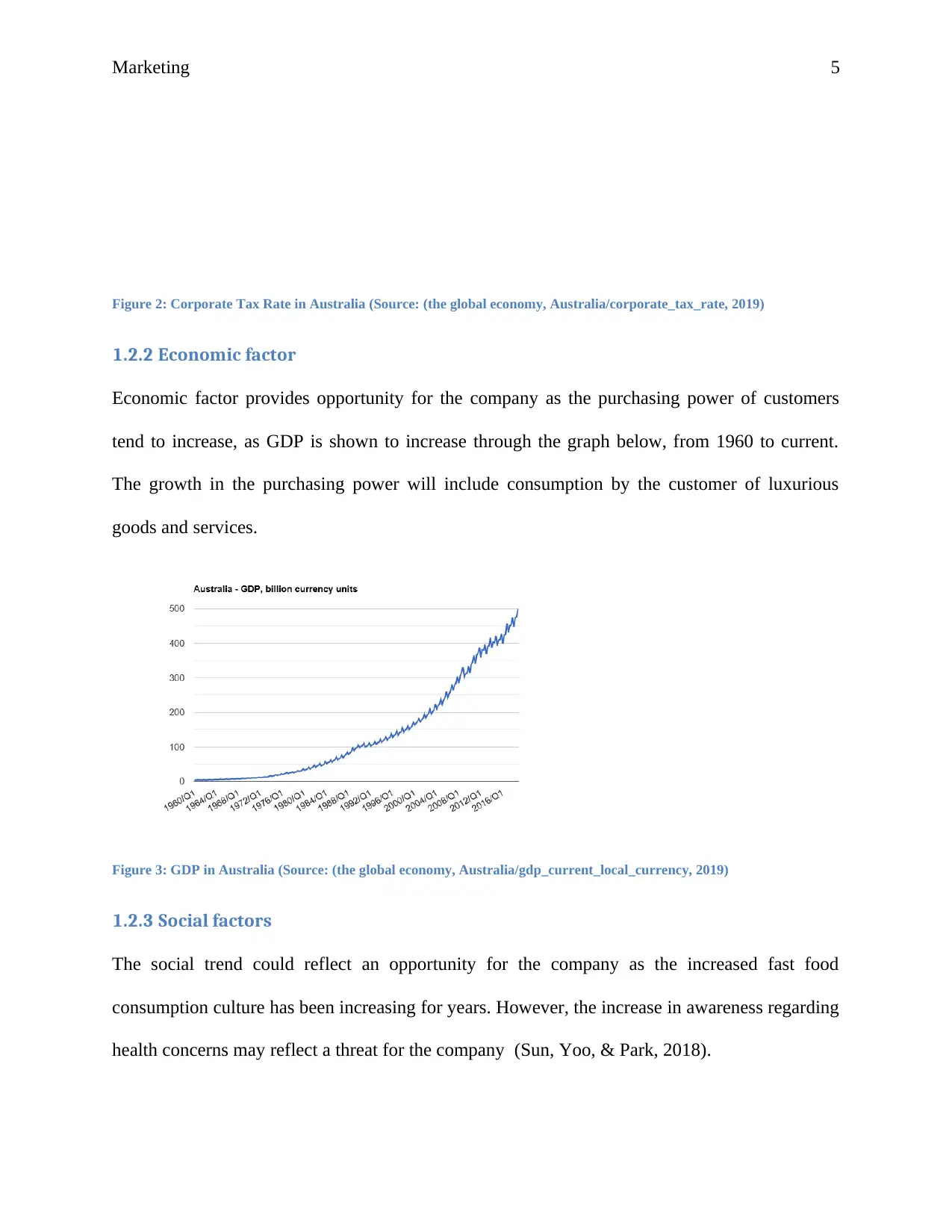
Marketing 5
Figure 2: Corporate Tax Rate in Australia (Source: (the global economy, Australia/corporate_tax_rate, 2019)
1.2.2 Economic factor
Economic factor provides opportunity for the company as the purchasing power of customers
tend to increase, as GDP is shown to increase through the graph below, from 1960 to current.
The growth in the purchasing power will include consumption by the customer of luxurious
goods and services.
Figure 3: GDP in Australia (Source: (the global economy, Australia/gdp_current_local_currency, 2019)
1.2.3 Social factors
The social trend could reflect an opportunity for the company as the increased fast food
consumption culture has been increasing for years. However, the increase in awareness regarding
health concerns may reflect a threat for the company (Sun, Yoo, & Park, 2018).
Figure 2: Corporate Tax Rate in Australia (Source: (the global economy, Australia/corporate_tax_rate, 2019)
1.2.2 Economic factor
Economic factor provides opportunity for the company as the purchasing power of customers
tend to increase, as GDP is shown to increase through the graph below, from 1960 to current.
The growth in the purchasing power will include consumption by the customer of luxurious
goods and services.
Figure 3: GDP in Australia (Source: (the global economy, Australia/gdp_current_local_currency, 2019)
1.2.3 Social factors
The social trend could reflect an opportunity for the company as the increased fast food
consumption culture has been increasing for years. However, the increase in awareness regarding
health concerns may reflect a threat for the company (Sun, Yoo, & Park, 2018).
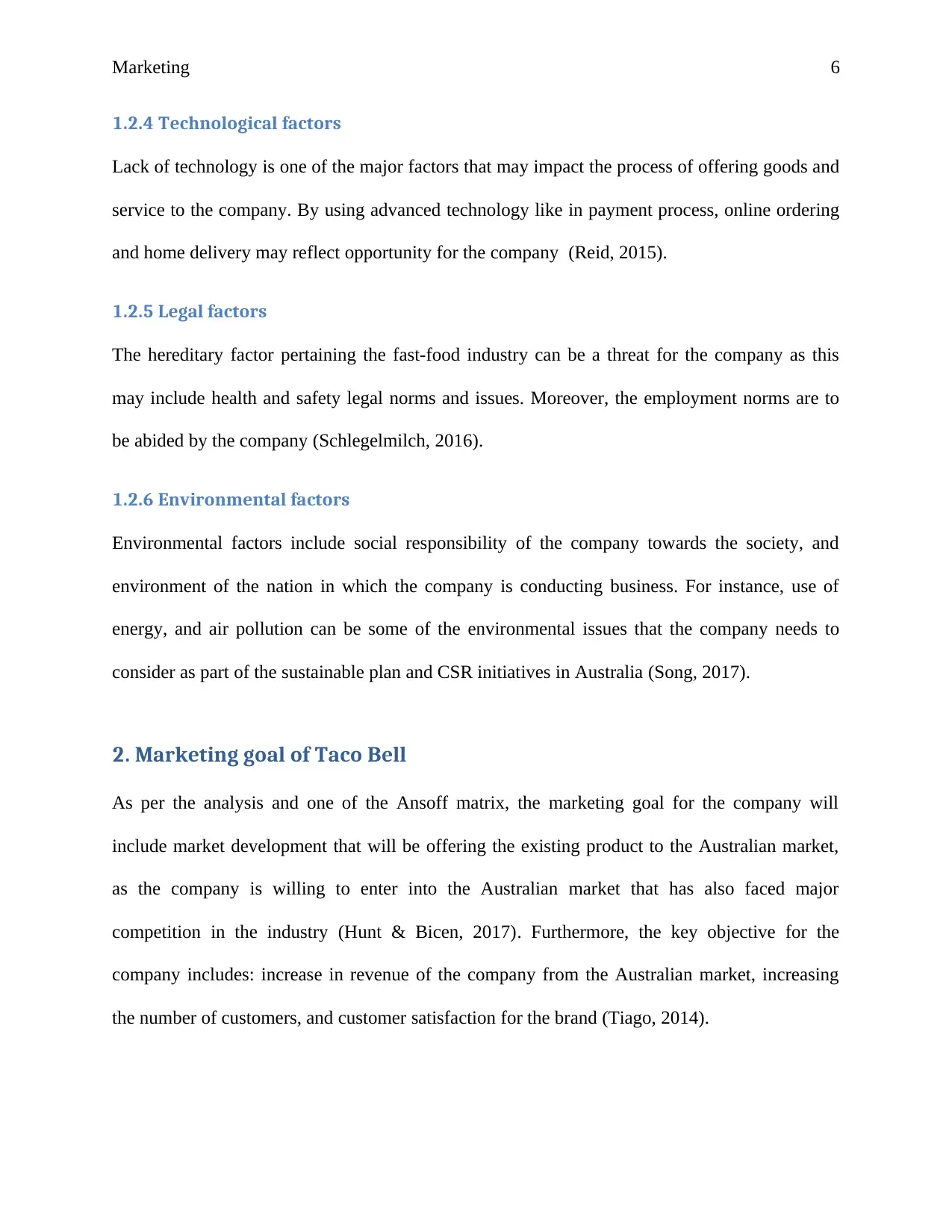
Marketing 6
1.2.4 Technological factors
Lack of technology is one of the major factors that may impact the process of offering goods and
service to the company. By using advanced technology like in payment process, online ordering
and home delivery may reflect opportunity for the company (Reid, 2015).
1.2.5 Legal factors
The hereditary factor pertaining the fast-food industry can be a threat for the company as this
may include health and safety legal norms and issues. Moreover, the employment norms are to
be abided by the company (Schlegelmilch, 2016).
1.2.6 Environmental factors
Environmental factors include social responsibility of the company towards the society, and
environment of the nation in which the company is conducting business. For instance, use of
energy, and air pollution can be some of the environmental issues that the company needs to
consider as part of the sustainable plan and CSR initiatives in Australia (Song, 2017).
2. Marketing goal of Taco Bell
As per the analysis and one of the Ansoff matrix, the marketing goal for the company will
include market development that will be offering the existing product to the Australian market,
as the company is willing to enter into the Australian market that has also faced major
competition in the industry (Hunt & Bicen, 2017). Furthermore, the key objective for the
company includes: increase in revenue of the company from the Australian market, increasing
the number of customers, and customer satisfaction for the brand (Tiago, 2014).
1.2.4 Technological factors
Lack of technology is one of the major factors that may impact the process of offering goods and
service to the company. By using advanced technology like in payment process, online ordering
and home delivery may reflect opportunity for the company (Reid, 2015).
1.2.5 Legal factors
The hereditary factor pertaining the fast-food industry can be a threat for the company as this
may include health and safety legal norms and issues. Moreover, the employment norms are to
be abided by the company (Schlegelmilch, 2016).
1.2.6 Environmental factors
Environmental factors include social responsibility of the company towards the society, and
environment of the nation in which the company is conducting business. For instance, use of
energy, and air pollution can be some of the environmental issues that the company needs to
consider as part of the sustainable plan and CSR initiatives in Australia (Song, 2017).
2. Marketing goal of Taco Bell
As per the analysis and one of the Ansoff matrix, the marketing goal for the company will
include market development that will be offering the existing product to the Australian market,
as the company is willing to enter into the Australian market that has also faced major
competition in the industry (Hunt & Bicen, 2017). Furthermore, the key objective for the
company includes: increase in revenue of the company from the Australian market, increasing
the number of customers, and customer satisfaction for the brand (Tiago, 2014).
Paraphrase This Document
Need a fresh take? Get an instant paraphrase of this document with our AI Paraphraser
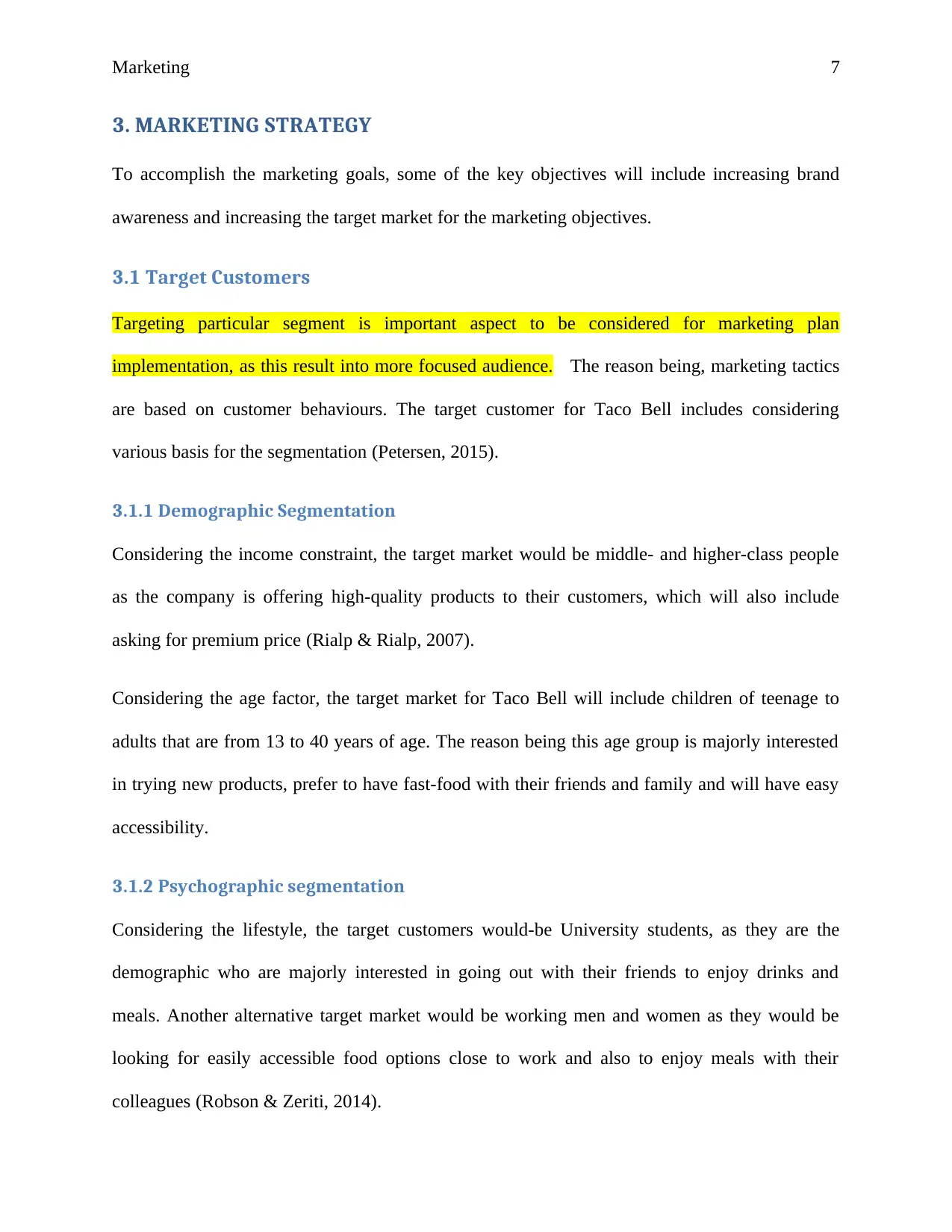
Marketing 7
3. MARKETING STRATEGY
To accomplish the marketing goals, some of the key objectives will include increasing brand
awareness and increasing the target market for the marketing objectives.
3.1 Target Customers
Targeting particular segment is important aspect to be considered for marketing plan
implementation, as this result into more focused audience. The reason being, marketing tactics
are based on customer behaviours. The target customer for Taco Bell includes considering
various basis for the segmentation (Petersen, 2015).
3.1.1 Demographic Segmentation
Considering the income constraint, the target market would be middle- and higher-class people
as the company is offering high-quality products to their customers, which will also include
asking for premium price (Rialp & Rialp, 2007).
Considering the age factor, the target market for Taco Bell will include children of teenage to
adults that are from 13 to 40 years of age. The reason being this age group is majorly interested
in trying new products, prefer to have fast-food with their friends and family and will have easy
accessibility.
3.1.2 Psychographic segmentation
Considering the lifestyle, the target customers would-be University students, as they are the
demographic who are majorly interested in going out with their friends to enjoy drinks and
meals. Another alternative target market would be working men and women as they would be
looking for easily accessible food options close to work and also to enjoy meals with their
colleagues (Robson & Zeriti, 2014).
3. MARKETING STRATEGY
To accomplish the marketing goals, some of the key objectives will include increasing brand
awareness and increasing the target market for the marketing objectives.
3.1 Target Customers
Targeting particular segment is important aspect to be considered for marketing plan
implementation, as this result into more focused audience. The reason being, marketing tactics
are based on customer behaviours. The target customer for Taco Bell includes considering
various basis for the segmentation (Petersen, 2015).
3.1.1 Demographic Segmentation
Considering the income constraint, the target market would be middle- and higher-class people
as the company is offering high-quality products to their customers, which will also include
asking for premium price (Rialp & Rialp, 2007).
Considering the age factor, the target market for Taco Bell will include children of teenage to
adults that are from 13 to 40 years of age. The reason being this age group is majorly interested
in trying new products, prefer to have fast-food with their friends and family and will have easy
accessibility.
3.1.2 Psychographic segmentation
Considering the lifestyle, the target customers would-be University students, as they are the
demographic who are majorly interested in going out with their friends to enjoy drinks and
meals. Another alternative target market would be working men and women as they would be
looking for easily accessible food options close to work and also to enjoy meals with their
colleagues (Robson & Zeriti, 2014).
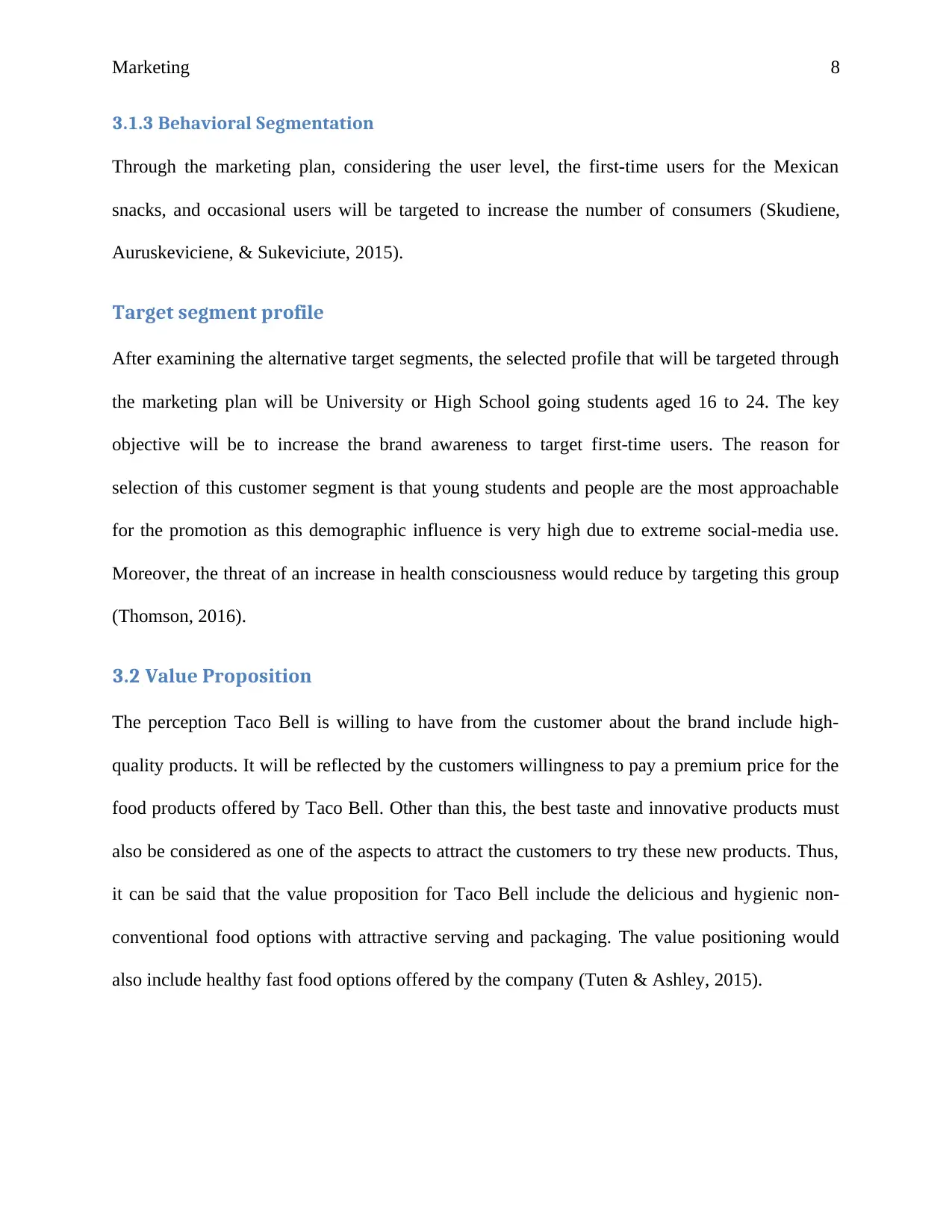
Marketing 8
3.1.3 Behavioral Segmentation
Through the marketing plan, considering the user level, the first-time users for the Mexican
snacks, and occasional users will be targeted to increase the number of consumers (Skudiene,
Auruskeviciene, & Sukeviciute, 2015).
Target segment profile
After examining the alternative target segments, the selected profile that will be targeted through
the marketing plan will be University or High School going students aged 16 to 24. The key
objective will be to increase the brand awareness to target first-time users. The reason for
selection of this customer segment is that young students and people are the most approachable
for the promotion as this demographic influence is very high due to extreme social-media use.
Moreover, the threat of an increase in health consciousness would reduce by targeting this group
(Thomson, 2016).
3.2 Value Proposition
The perception Taco Bell is willing to have from the customer about the brand include high-
quality products. It will be reflected by the customers willingness to pay a premium price for the
food products offered by Taco Bell. Other than this, the best taste and innovative products must
also be considered as one of the aspects to attract the customers to try these new products. Thus,
it can be said that the value proposition for Taco Bell include the delicious and hygienic non-
conventional food options with attractive serving and packaging. The value positioning would
also include healthy fast food options offered by the company (Tuten & Ashley, 2015).
3.1.3 Behavioral Segmentation
Through the marketing plan, considering the user level, the first-time users for the Mexican
snacks, and occasional users will be targeted to increase the number of consumers (Skudiene,
Auruskeviciene, & Sukeviciute, 2015).
Target segment profile
After examining the alternative target segments, the selected profile that will be targeted through
the marketing plan will be University or High School going students aged 16 to 24. The key
objective will be to increase the brand awareness to target first-time users. The reason for
selection of this customer segment is that young students and people are the most approachable
for the promotion as this demographic influence is very high due to extreme social-media use.
Moreover, the threat of an increase in health consciousness would reduce by targeting this group
(Thomson, 2016).
3.2 Value Proposition
The perception Taco Bell is willing to have from the customer about the brand include high-
quality products. It will be reflected by the customers willingness to pay a premium price for the
food products offered by Taco Bell. Other than this, the best taste and innovative products must
also be considered as one of the aspects to attract the customers to try these new products. Thus,
it can be said that the value proposition for Taco Bell include the delicious and hygienic non-
conventional food options with attractive serving and packaging. The value positioning would
also include healthy fast food options offered by the company (Tuten & Ashley, 2015).
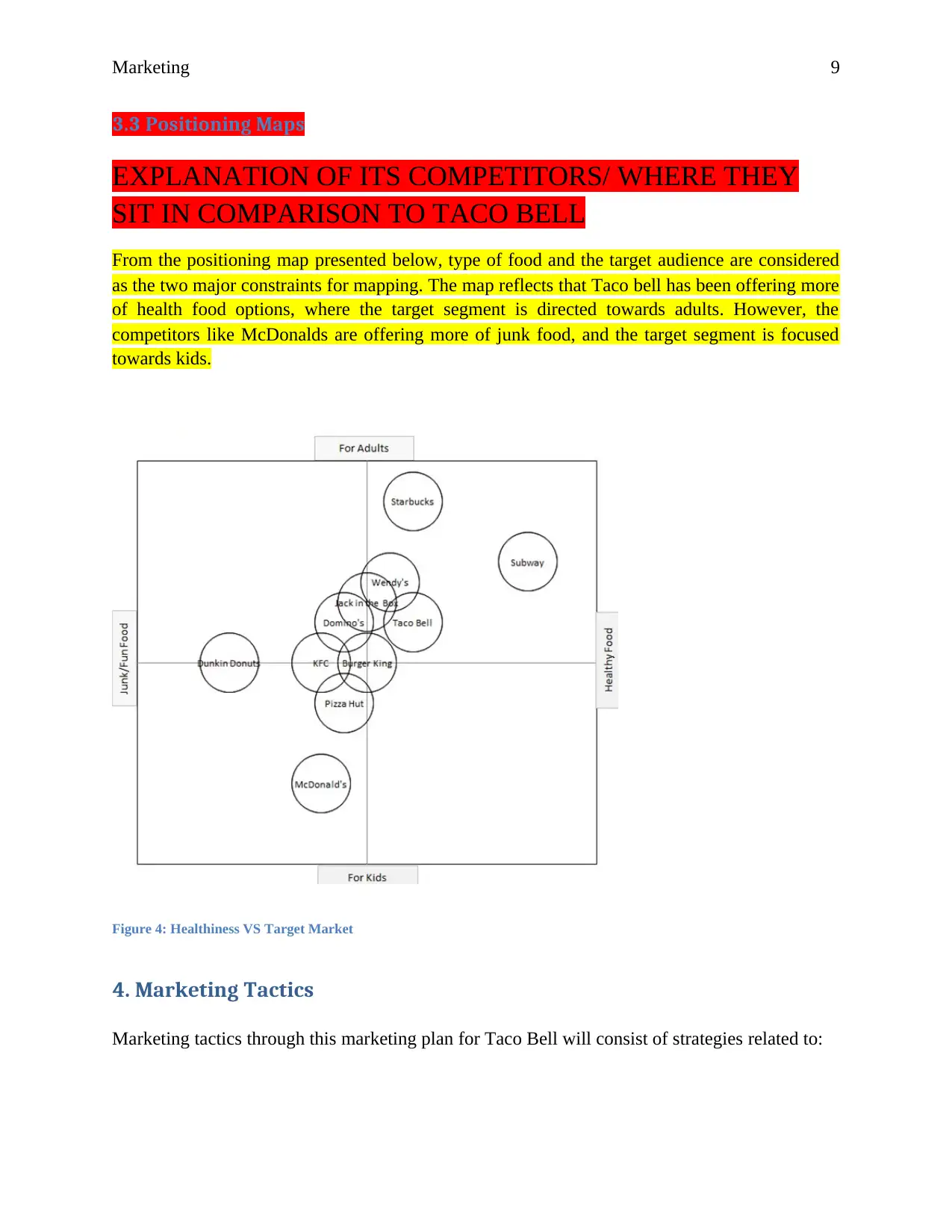
Marketing 9
3.3 Positioning Maps
EXPLANATION OF ITS COMPETITORS/ WHERE THEY
SIT IN COMPARISON TO TACO BELL
From the positioning map presented below, type of food and the target audience are considered
as the two major constraints for mapping. The map reflects that Taco bell has been offering more
of health food options, where the target segment is directed towards adults. However, the
competitors like McDonalds are offering more of junk food, and the target segment is focused
towards kids.
Figure 4: Healthiness VS Target Market
4. Marketing Tactics
Marketing tactics through this marketing plan for Taco Bell will consist of strategies related to:
3.3 Positioning Maps
EXPLANATION OF ITS COMPETITORS/ WHERE THEY
SIT IN COMPARISON TO TACO BELL
From the positioning map presented below, type of food and the target audience are considered
as the two major constraints for mapping. The map reflects that Taco bell has been offering more
of health food options, where the target segment is directed towards adults. However, the
competitors like McDonalds are offering more of junk food, and the target segment is focused
towards kids.
Figure 4: Healthiness VS Target Market
4. Marketing Tactics
Marketing tactics through this marketing plan for Taco Bell will consist of strategies related to:
Secure Best Marks with AI Grader
Need help grading? Try our AI Grader for instant feedback on your assignments.
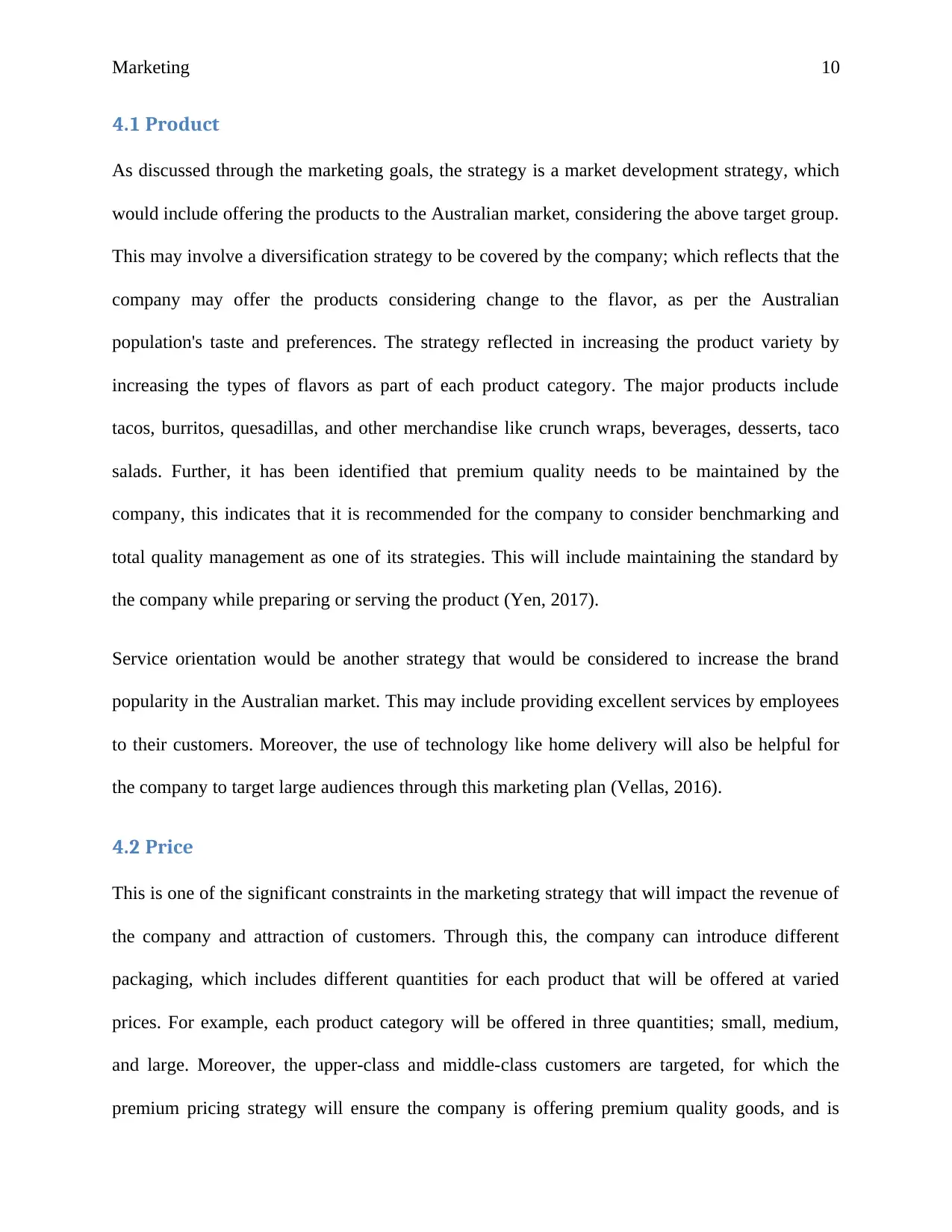
Marketing 10
4.1 Product
As discussed through the marketing goals, the strategy is a market development strategy, which
would include offering the products to the Australian market, considering the above target group.
This may involve a diversification strategy to be covered by the company; which reflects that the
company may offer the products considering change to the flavor, as per the Australian
population's taste and preferences. The strategy reflected in increasing the product variety by
increasing the types of flavors as part of each product category. The major products include
tacos, burritos, quesadillas, and other merchandise like crunch wraps, beverages, desserts, taco
salads. Further, it has been identified that premium quality needs to be maintained by the
company, this indicates that it is recommended for the company to consider benchmarking and
total quality management as one of its strategies. This will include maintaining the standard by
the company while preparing or serving the product (Yen, 2017).
Service orientation would be another strategy that would be considered to increase the brand
popularity in the Australian market. This may include providing excellent services by employees
to their customers. Moreover, the use of technology like home delivery will also be helpful for
the company to target large audiences through this marketing plan (Vellas, 2016).
4.2 Price
This is one of the significant constraints in the marketing strategy that will impact the revenue of
the company and attraction of customers. Through this, the company can introduce different
packaging, which includes different quantities for each product that will be offered at varied
prices. For example, each product category will be offered in three quantities; small, medium,
and large. Moreover, the upper-class and middle-class customers are targeted, for which the
premium pricing strategy will ensure the company is offering premium quality goods, and is
4.1 Product
As discussed through the marketing goals, the strategy is a market development strategy, which
would include offering the products to the Australian market, considering the above target group.
This may involve a diversification strategy to be covered by the company; which reflects that the
company may offer the products considering change to the flavor, as per the Australian
population's taste and preferences. The strategy reflected in increasing the product variety by
increasing the types of flavors as part of each product category. The major products include
tacos, burritos, quesadillas, and other merchandise like crunch wraps, beverages, desserts, taco
salads. Further, it has been identified that premium quality needs to be maintained by the
company, this indicates that it is recommended for the company to consider benchmarking and
total quality management as one of its strategies. This will include maintaining the standard by
the company while preparing or serving the product (Yen, 2017).
Service orientation would be another strategy that would be considered to increase the brand
popularity in the Australian market. This may include providing excellent services by employees
to their customers. Moreover, the use of technology like home delivery will also be helpful for
the company to target large audiences through this marketing plan (Vellas, 2016).
4.2 Price
This is one of the significant constraints in the marketing strategy that will impact the revenue of
the company and attraction of customers. Through this, the company can introduce different
packaging, which includes different quantities for each product that will be offered at varied
prices. For example, each product category will be offered in three quantities; small, medium,
and large. Moreover, the upper-class and middle-class customers are targeted, for which the
premium pricing strategy will ensure the company is offering premium quality goods, and is
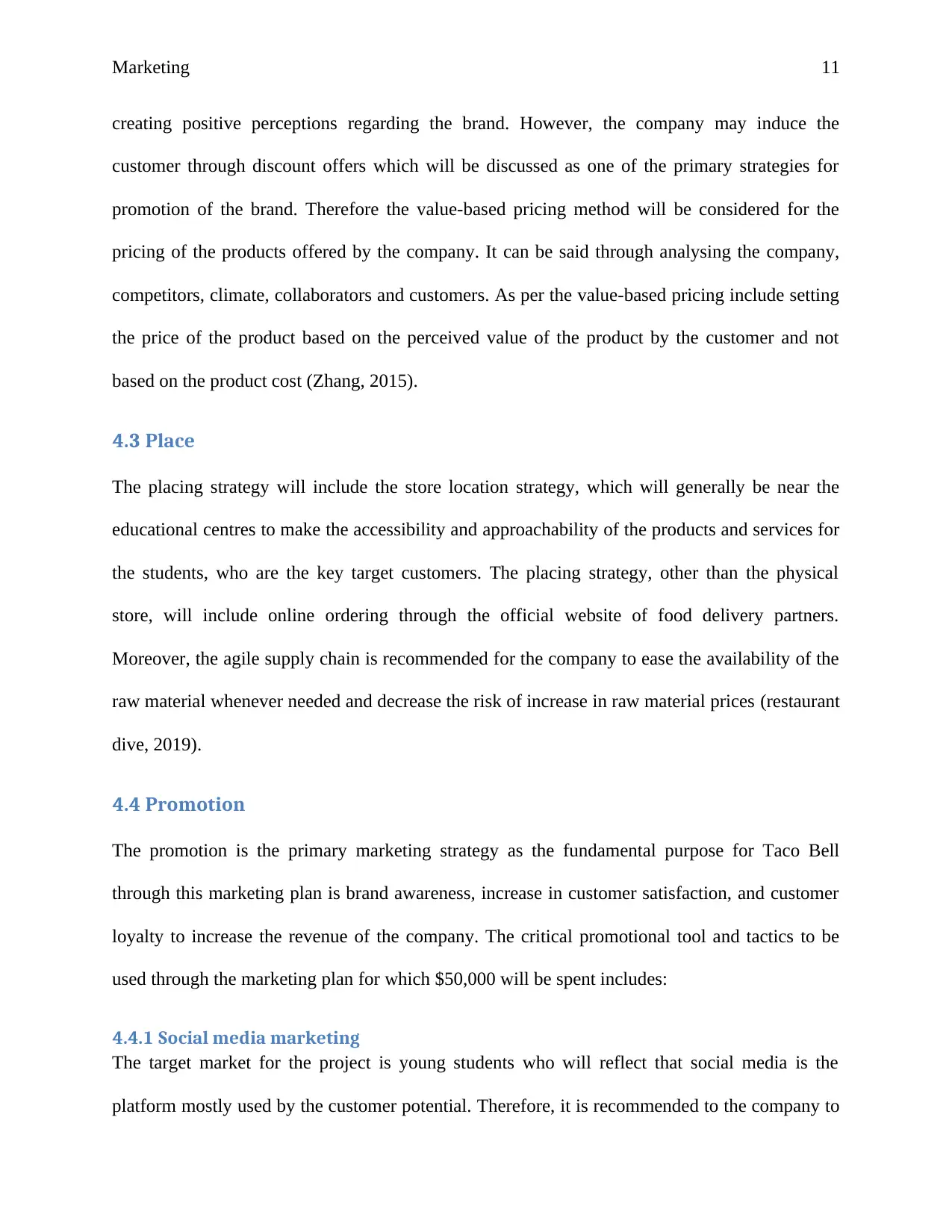
Marketing 11
creating positive perceptions regarding the brand. However, the company may induce the
customer through discount offers which will be discussed as one of the primary strategies for
promotion of the brand. Therefore the value-based pricing method will be considered for the
pricing of the products offered by the company. It can be said through analysing the company,
competitors, climate, collaborators and customers. As per the value-based pricing include setting
the price of the product based on the perceived value of the product by the customer and not
based on the product cost (Zhang, 2015).
4.3 Place
The placing strategy will include the store location strategy, which will generally be near the
educational centres to make the accessibility and approachability of the products and services for
the students, who are the key target customers. The placing strategy, other than the physical
store, will include online ordering through the official website of food delivery partners.
Moreover, the agile supply chain is recommended for the company to ease the availability of the
raw material whenever needed and decrease the risk of increase in raw material prices (restaurant
dive, 2019).
4.4 Promotion
The promotion is the primary marketing strategy as the fundamental purpose for Taco Bell
through this marketing plan is brand awareness, increase in customer satisfaction, and customer
loyalty to increase the revenue of the company. The critical promotional tool and tactics to be
used through the marketing plan for which $50,000 will be spent includes:
4.4.1 Social media marketing
The target market for the project is young students who will reflect that social media is the
platform mostly used by the customer potential. Therefore, it is recommended to the company to
creating positive perceptions regarding the brand. However, the company may induce the
customer through discount offers which will be discussed as one of the primary strategies for
promotion of the brand. Therefore the value-based pricing method will be considered for the
pricing of the products offered by the company. It can be said through analysing the company,
competitors, climate, collaborators and customers. As per the value-based pricing include setting
the price of the product based on the perceived value of the product by the customer and not
based on the product cost (Zhang, 2015).
4.3 Place
The placing strategy will include the store location strategy, which will generally be near the
educational centres to make the accessibility and approachability of the products and services for
the students, who are the key target customers. The placing strategy, other than the physical
store, will include online ordering through the official website of food delivery partners.
Moreover, the agile supply chain is recommended for the company to ease the availability of the
raw material whenever needed and decrease the risk of increase in raw material prices (restaurant
dive, 2019).
4.4 Promotion
The promotion is the primary marketing strategy as the fundamental purpose for Taco Bell
through this marketing plan is brand awareness, increase in customer satisfaction, and customer
loyalty to increase the revenue of the company. The critical promotional tool and tactics to be
used through the marketing plan for which $50,000 will be spent includes:
4.4.1 Social media marketing
The target market for the project is young students who will reflect that social media is the
platform mostly used by the customer potential. Therefore, it is recommended to the company to
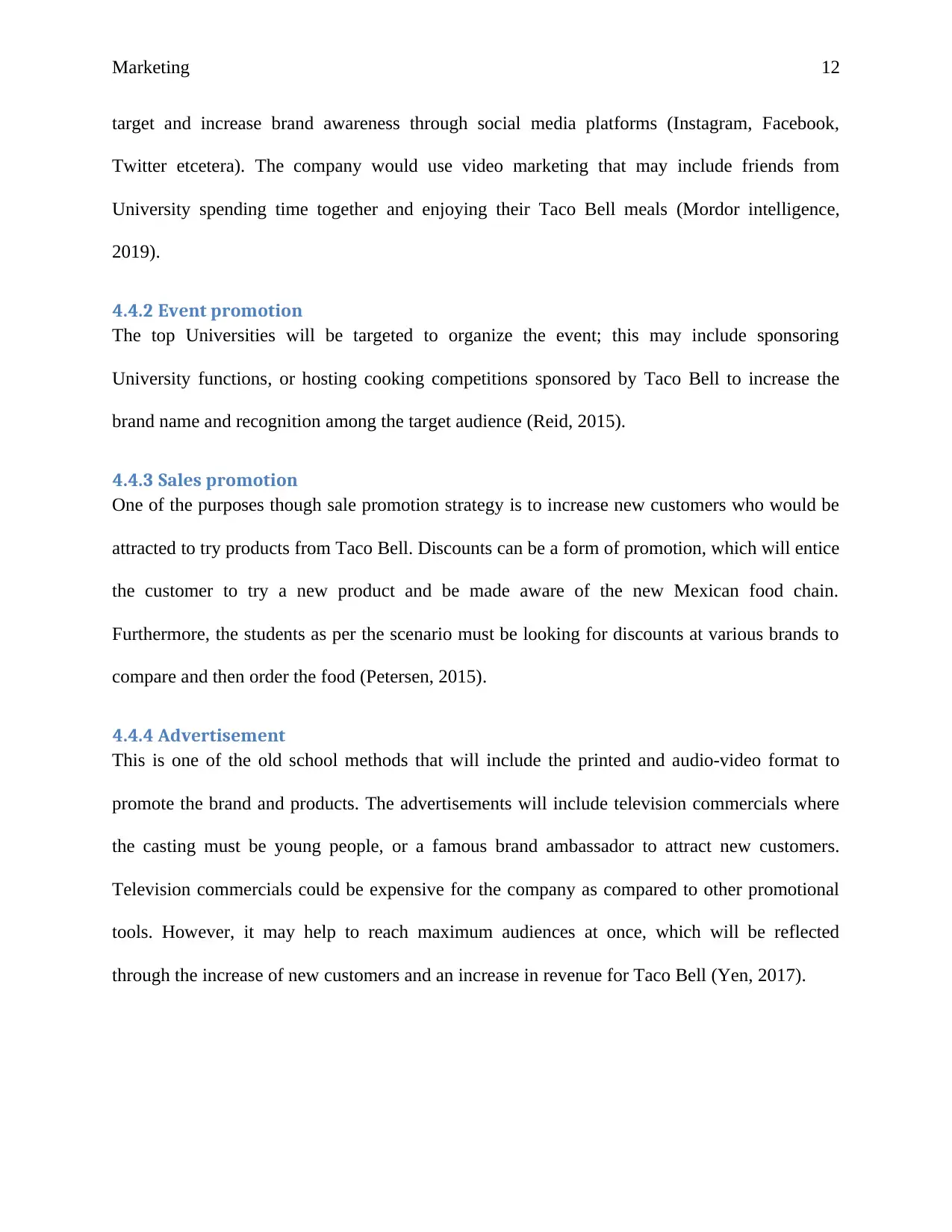
Marketing 12
target and increase brand awareness through social media platforms (Instagram, Facebook,
Twitter etcetera). The company would use video marketing that may include friends from
University spending time together and enjoying their Taco Bell meals (Mordor intelligence,
2019).
4.4.2 Event promotion
The top Universities will be targeted to organize the event; this may include sponsoring
University functions, or hosting cooking competitions sponsored by Taco Bell to increase the
brand name and recognition among the target audience (Reid, 2015).
4.4.3 Sales promotion
One of the purposes though sale promotion strategy is to increase new customers who would be
attracted to try products from Taco Bell. Discounts can be a form of promotion, which will entice
the customer to try a new product and be made aware of the new Mexican food chain.
Furthermore, the students as per the scenario must be looking for discounts at various brands to
compare and then order the food (Petersen, 2015).
4.4.4 Advertisement
This is one of the old school methods that will include the printed and audio-video format to
promote the brand and products. The advertisements will include television commercials where
the casting must be young people, or a famous brand ambassador to attract new customers.
Television commercials could be expensive for the company as compared to other promotional
tools. However, it may help to reach maximum audiences at once, which will be reflected
through the increase of new customers and an increase in revenue for Taco Bell (Yen, 2017).
target and increase brand awareness through social media platforms (Instagram, Facebook,
Twitter etcetera). The company would use video marketing that may include friends from
University spending time together and enjoying their Taco Bell meals (Mordor intelligence,
2019).
4.4.2 Event promotion
The top Universities will be targeted to organize the event; this may include sponsoring
University functions, or hosting cooking competitions sponsored by Taco Bell to increase the
brand name and recognition among the target audience (Reid, 2015).
4.4.3 Sales promotion
One of the purposes though sale promotion strategy is to increase new customers who would be
attracted to try products from Taco Bell. Discounts can be a form of promotion, which will entice
the customer to try a new product and be made aware of the new Mexican food chain.
Furthermore, the students as per the scenario must be looking for discounts at various brands to
compare and then order the food (Petersen, 2015).
4.4.4 Advertisement
This is one of the old school methods that will include the printed and audio-video format to
promote the brand and products. The advertisements will include television commercials where
the casting must be young people, or a famous brand ambassador to attract new customers.
Television commercials could be expensive for the company as compared to other promotional
tools. However, it may help to reach maximum audiences at once, which will be reflected
through the increase of new customers and an increase in revenue for Taco Bell (Yen, 2017).
Paraphrase This Document
Need a fresh take? Get an instant paraphrase of this document with our AI Paraphraser
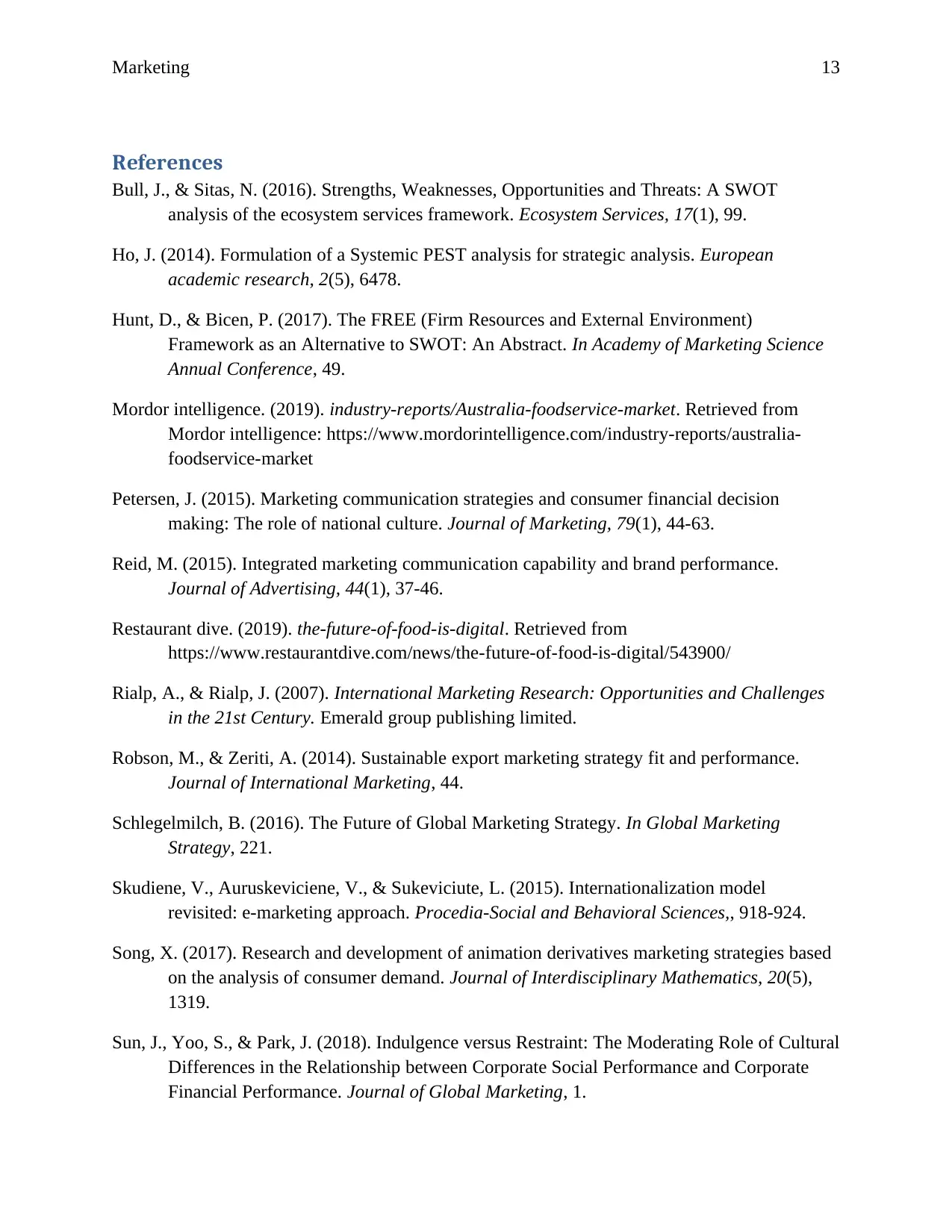
Marketing 13
References
Bull, J., & Sitas, N. (2016). Strengths, Weaknesses, Opportunities and Threats: A SWOT
analysis of the ecosystem services framework. Ecosystem Services, 17(1), 99.
Ho, J. (2014). Formulation of a Systemic PEST analysis for strategic analysis. European
academic research, 2(5), 6478.
Hunt, D., & Bicen, P. (2017). The FREE (Firm Resources and External Environment)
Framework as an Alternative to SWOT: An Abstract. In Academy of Marketing Science
Annual Conference, 49.
Mordor intelligence. (2019). industry-reports/Australia-foodservice-market. Retrieved from
Mordor intelligence: https://www.mordorintelligence.com/industry-reports/australia-
foodservice-market
Petersen, J. (2015). Marketing communication strategies and consumer financial decision
making: The role of national culture. Journal of Marketing, 79(1), 44-63.
Reid, M. (2015). Integrated marketing communication capability and brand performance.
Journal of Advertising, 44(1), 37-46.
Restaurant dive. (2019). the-future-of-food-is-digital. Retrieved from
https://www.restaurantdive.com/news/the-future-of-food-is-digital/543900/
Rialp, A., & Rialp, J. (2007). International Marketing Research: Opportunities and Challenges
in the 21st Century. Emerald group publishing limited.
Robson, M., & Zeriti, A. (2014). Sustainable export marketing strategy fit and performance.
Journal of International Marketing, 44.
Schlegelmilch, B. (2016). The Future of Global Marketing Strategy. In Global Marketing
Strategy, 221.
Skudiene, V., Auruskeviciene, V., & Sukeviciute, L. (2015). Internationalization model
revisited: e-marketing approach. Procedia-Social and Behavioral Sciences,, 918-924.
Song, X. (2017). Research and development of animation derivatives marketing strategies based
on the analysis of consumer demand. Journal of Interdisciplinary Mathematics, 20(5),
1319.
Sun, J., Yoo, S., & Park, J. (2018). Indulgence versus Restraint: The Moderating Role of Cultural
Differences in the Relationship between Corporate Social Performance and Corporate
Financial Performance. Journal of Global Marketing, 1.
References
Bull, J., & Sitas, N. (2016). Strengths, Weaknesses, Opportunities and Threats: A SWOT
analysis of the ecosystem services framework. Ecosystem Services, 17(1), 99.
Ho, J. (2014). Formulation of a Systemic PEST analysis for strategic analysis. European
academic research, 2(5), 6478.
Hunt, D., & Bicen, P. (2017). The FREE (Firm Resources and External Environment)
Framework as an Alternative to SWOT: An Abstract. In Academy of Marketing Science
Annual Conference, 49.
Mordor intelligence. (2019). industry-reports/Australia-foodservice-market. Retrieved from
Mordor intelligence: https://www.mordorintelligence.com/industry-reports/australia-
foodservice-market
Petersen, J. (2015). Marketing communication strategies and consumer financial decision
making: The role of national culture. Journal of Marketing, 79(1), 44-63.
Reid, M. (2015). Integrated marketing communication capability and brand performance.
Journal of Advertising, 44(1), 37-46.
Restaurant dive. (2019). the-future-of-food-is-digital. Retrieved from
https://www.restaurantdive.com/news/the-future-of-food-is-digital/543900/
Rialp, A., & Rialp, J. (2007). International Marketing Research: Opportunities and Challenges
in the 21st Century. Emerald group publishing limited.
Robson, M., & Zeriti, A. (2014). Sustainable export marketing strategy fit and performance.
Journal of International Marketing, 44.
Schlegelmilch, B. (2016). The Future of Global Marketing Strategy. In Global Marketing
Strategy, 221.
Skudiene, V., Auruskeviciene, V., & Sukeviciute, L. (2015). Internationalization model
revisited: e-marketing approach. Procedia-Social and Behavioral Sciences,, 918-924.
Song, X. (2017). Research and development of animation derivatives marketing strategies based
on the analysis of consumer demand. Journal of Interdisciplinary Mathematics, 20(5),
1319.
Sun, J., Yoo, S., & Park, J. (2018). Indulgence versus Restraint: The Moderating Role of Cultural
Differences in the Relationship between Corporate Social Performance and Corporate
Financial Performance. Journal of Global Marketing, 1.
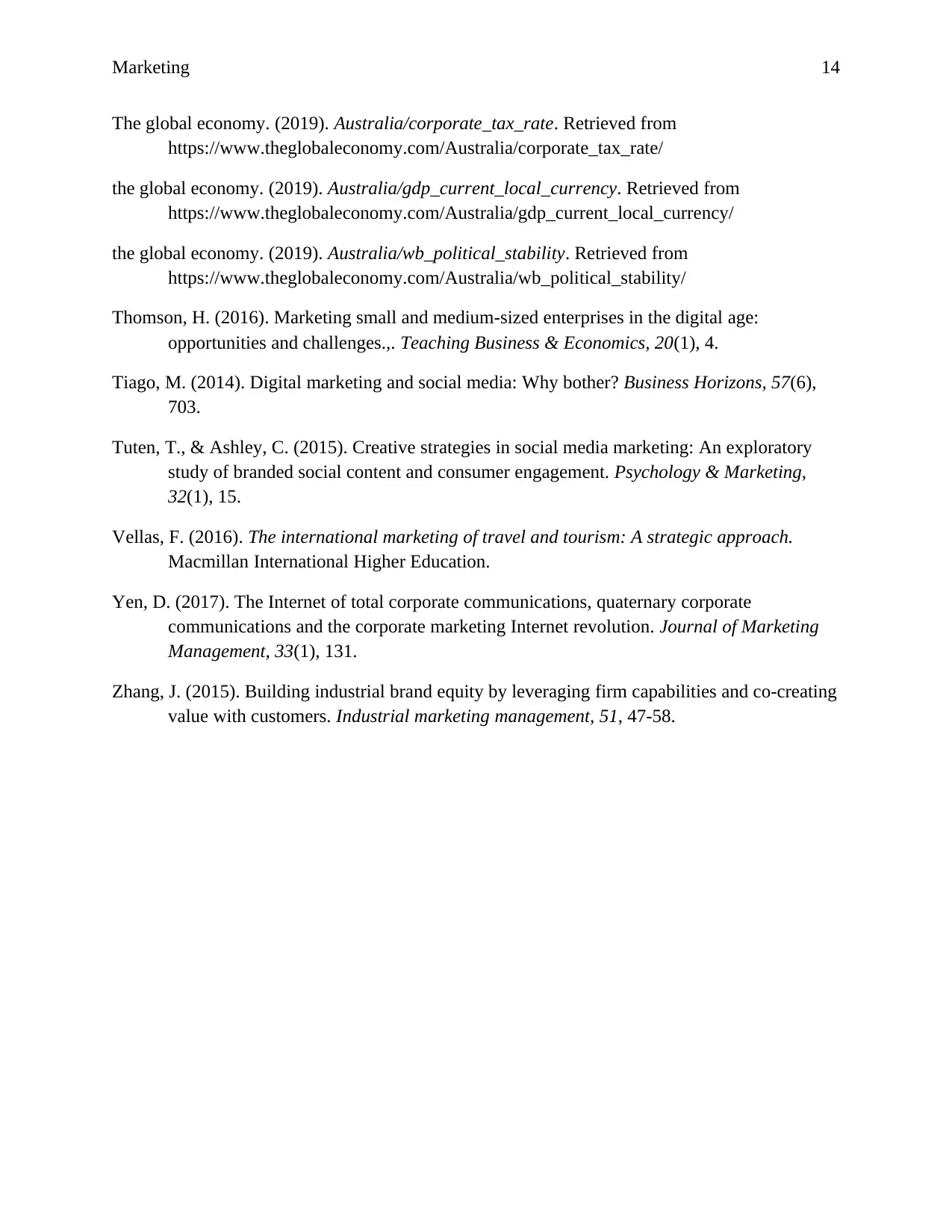
Marketing 14
The global economy. (2019). Australia/corporate_tax_rate. Retrieved from
https://www.theglobaleconomy.com/Australia/corporate_tax_rate/
the global economy. (2019). Australia/gdp_current_local_currency. Retrieved from
https://www.theglobaleconomy.com/Australia/gdp_current_local_currency/
the global economy. (2019). Australia/wb_political_stability. Retrieved from
https://www.theglobaleconomy.com/Australia/wb_political_stability/
Thomson, H. (2016). Marketing small and medium-sized enterprises in the digital age:
opportunities and challenges.,. Teaching Business & Economics, 20(1), 4.
Tiago, M. (2014). Digital marketing and social media: Why bother? Business Horizons, 57(6),
703.
Tuten, T., & Ashley, C. (2015). Creative strategies in social media marketing: An exploratory
study of branded social content and consumer engagement. Psychology & Marketing,
32(1), 15.
Vellas, F. (2016). The international marketing of travel and tourism: A strategic approach.
Macmillan International Higher Education.
Yen, D. (2017). The Internet of total corporate communications, quaternary corporate
communications and the corporate marketing Internet revolution. Journal of Marketing
Management, 33(1), 131.
Zhang, J. (2015). Building industrial brand equity by leveraging firm capabilities and co-creating
value with customers. Industrial marketing management, 51, 47-58.
The global economy. (2019). Australia/corporate_tax_rate. Retrieved from
https://www.theglobaleconomy.com/Australia/corporate_tax_rate/
the global economy. (2019). Australia/gdp_current_local_currency. Retrieved from
https://www.theglobaleconomy.com/Australia/gdp_current_local_currency/
the global economy. (2019). Australia/wb_political_stability. Retrieved from
https://www.theglobaleconomy.com/Australia/wb_political_stability/
Thomson, H. (2016). Marketing small and medium-sized enterprises in the digital age:
opportunities and challenges.,. Teaching Business & Economics, 20(1), 4.
Tiago, M. (2014). Digital marketing and social media: Why bother? Business Horizons, 57(6),
703.
Tuten, T., & Ashley, C. (2015). Creative strategies in social media marketing: An exploratory
study of branded social content and consumer engagement. Psychology & Marketing,
32(1), 15.
Vellas, F. (2016). The international marketing of travel and tourism: A strategic approach.
Macmillan International Higher Education.
Yen, D. (2017). The Internet of total corporate communications, quaternary corporate
communications and the corporate marketing Internet revolution. Journal of Marketing
Management, 33(1), 131.
Zhang, J. (2015). Building industrial brand equity by leveraging firm capabilities and co-creating
value with customers. Industrial marketing management, 51, 47-58.
1 out of 15
Related Documents
Your All-in-One AI-Powered Toolkit for Academic Success.
+13062052269
info@desklib.com
Available 24*7 on WhatsApp / Email
![[object Object]](/_next/static/media/star-bottom.7253800d.svg)
Unlock your academic potential
© 2024 | Zucol Services PVT LTD | All rights reserved.



